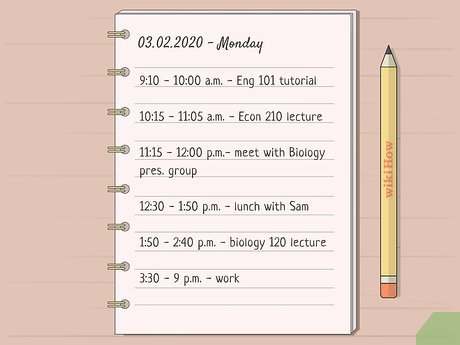Last Updated on May 22, 2025 by Kavya K
Creating a Daily To-Do List That Actually Works
We’ve all been there — staring at a long list of tasks, feeling overwhelmed, and unsure of where to start. A to-do list can be one of the most powerful tools for managing your day, but only if it’s organized effectively. A poorly structured list can end up causing more stress and confusion, making it harder to stay focused and get things done. On the other hand, a well-crafted to-do list can provide clarity, motivation, and a sense of accomplishment.
In this article, we’ll walk you through how to create a daily to-do list that actually works, ensuring it becomes a tool for productivity rather than a source of stress.
Why a To-Do List is Essential for Productivity
A to-do list is more than just a simple list of tasks; it’s a tool to help you stay organized, prioritize your time, and track your progress. Having a clear list of what needs to be done allows you to approach your day with focus and clarity. Whether you’re working from home, managing multiple projects, or juggling personal and professional responsibilities, a well-organized to-do list can make all the difference.
Some benefits of using a to-do list include:
- Increased Focus: A to-do list helps you narrow your focus to what truly matters, reducing the likelihood of distractions.
- Reduced Stress: By writing down everything you need to do, you free up mental space and avoid the anxiety of forgetting something important.
- Sense of Accomplishment: Checking off completed tasks provides a psychological boost and motivates you to continue making progress.
- Better Time Management: A to-do list helps you allocate time for each task, ensuring you use your time effectively and efficiently.
The key is to create a list that is realistic, actionable, and motivating, so you can stay on top of your responsibilities without feeling overwhelmed.
Step 1: Prioritize Your Tasks
Not all tasks are created equal, and trying to tackle everything at once can be counterproductive. Start by prioritizing your tasks to focus on the most important ones first.
- Use the Eisenhower Matrix: This method categorizes tasks into four quadrants:
- Urgent and important (Do these first)
- Important but not urgent (Schedule these for later)
- Urgent but not important (Delegate these if possible)
- Neither urgent nor important (Eliminate or postpone these tasks)
- The 1-3-5 Rule: This is a simple method for balancing your to-do list. Identify one big task, three medium tasks, and five small tasks that you want to accomplish in a day. By breaking your tasks into different categories, you prevent yourself from feeling overwhelmed.
- Focus on Your MITs (Most Important Tasks): Identify 1-3 tasks each day that are your top priorities. These are the tasks that will make the biggest impact on your goals, and you should aim to complete them first.
Step 2: Break Down Large Tasks into Actionable Steps
Large tasks can feel daunting and difficult to approach, often leading to procrastination. The key to overcoming this is breaking them down into smaller, more manageable steps.
- Divide Tasks into Smaller Pieces: For example, if your task is “Write a report,” break it down into smaller tasks such as “Outline the report,” “Write the introduction,” and “Revise the first draft.” This makes the task less overwhelming and gives you clear milestones to work toward.
- Set Clear Deadlines for Each Step: Rather than simply writing down a large task, set deadlines for each individual action step. This gives you a sense of urgency and helps keep you on track.
- Focus on One Step at a Time: By focusing on one small action at a time, you avoid getting distracted by the overall complexity of the task. Complete one small part, check it off, and then move on to the next.
Step 3: Use Digital Tools for a Seamless Experience
While paper lists can work well for some people, digital to-do lists offer additional advantages, such as portability, reminders, and the ability to sync across devices. If you want to create a daily to-do list that actually works, consider using some of the following digital tools:
- Todoist: This app is highly flexible and allows you to create task lists, set priorities, and add deadlines. It syncs across devices and can be integrated with other tools like Google Calendar.
- Trello: If you prefer a visual to-do list, Trello allows you to create boards, lists, and cards for each task. You can easily move tasks around as your priorities shift.
- Microsoft To Do: This simple yet powerful app integrates with other Microsoft products and offers a streamlined way to create and manage tasks, set deadlines, and create recurring reminders.
- Google Keep: For a more minimalist approach, Google Keep lets you create simple to-do lists with the added benefit of voice memos, image capturing, and location-based reminders.
- Notion: If you need a more comprehensive approach, Notion combines to-do lists with note-taking and project management tools, allowing you to track your tasks, organize your notes, and manage projects all in one place.
Step 4: Set Realistic and Achievable Goals
A to-do list can only work if you set yourself up for success by being realistic about how much you can accomplish in a day. Setting too many tasks or overly ambitious goals can lead to disappointment and burnout.
- Be Realistic About Time: Estimate how long each task will take and ensure you’re allocating enough time to complete each one. If you don’t have enough time to do everything, adjust your list to reflect only the most important tasks.
- Set Achievable Goals: It’s better to accomplish a few tasks thoroughly than to rush through many tasks. Make sure your to-do list reflects your energy and focus levels, and don’t be afraid to push less important tasks to the next day.
- Avoid Over-Scheduling: A jam-packed schedule can lead to feelings of overwhelm. Leave time for breaks, unexpected events, or rest throughout the day.
Step 5: Review and Adjust Your List Regularly
Your to-do list should be a living document, adaptable to the changing demands of your day. Regularly reviewing and adjusting your list helps you stay focused and prevents unnecessary stress.
- Review Your Progress: At the end of the day, review the tasks you’ve completed and reflect on what worked well and what didn’t. This will help you adjust your approach the next day.
- Move Unfinished Tasks to Tomorrow: If you didn’t finish a task, rather than feeling discouraged, move it to the top of tomorrow’s list. Consider if it’s still a priority or if it can be restructured into a smaller step.
- Celebrate Small Wins: Don’t forget to acknowledge the tasks you’ve completed, even if they’re small. Celebrating these victories, no matter how minor, helps build momentum for future productivity.
Step 6: Use Time-Blocking to Boost Efficiency
Time-blocking is a technique that involves scheduling specific blocks of time for focused work on particular tasks. By blocking off time for each task, you prevent distractions and stay on track throughout the day.
- Set Time Limits for Tasks: Instead of letting tasks drag on, assign a specific time slot to each item on your to-do list. For example, set aside 30 minutes to work on a report, then move on to the next task.
- Use the Pomodoro Technique: This time management method involves working for 25-minute intervals followed by a 5-minute break. After four cycles, take a longer break. Using a timer can help you stay focused and avoid burnout.
Conclusion: Building a To-Do List that Works for You
Creating a daily to-do list that actually works is about more than just writing down tasks. It’s about prioritizing, breaking tasks into manageable steps, using the right tools, and being realistic about what you can achieve in a day. By following these strategies, you’ll transform your to-do list from a source of stress into a powerful tool that helps you stay focused, productive, and organized.
Remember, the most effective to-do list is one that fits your personal workflow, enhances your productivity, and helps you move closer to your goals. Whether you prefer paper or digital lists, focus on quality over quantity and adjust your list as needed to ensure you’re making real progress each day.










